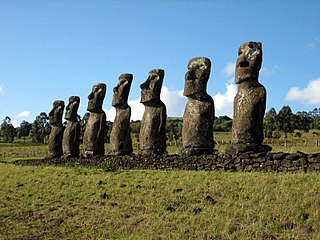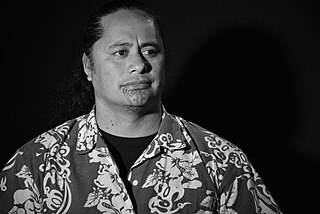Related Research Articles

Easter Island is an island and special territory of Chile in the southeastern Pacific Ocean, at the southeasternmost point of the Polynesian Triangle in Oceania. The island is most famous for its nearly 1,000 extant monumental statues, called moai, which were created by the early Rapa Nui people. In 1995, UNESCO named Easter Island a World Heritage Site, with much of the island protected within Rapa Nui National Park.

Hanga Roa is the main town, harbour and seat of Easter Island, a municipality of Chile. It is located in the southern part of the island's west coast, in the lowlands between the extinct volcanoes of Terevaka and Rano Kau.

The Rapa Nui are the Polynesian peoples indigenous to Easter Island. The easternmost Polynesian culture, the descendants of the original people of Easter Island make up about 60% of the current Easter Island population and have a significant portion of their population residing in mainland Chile. They speak both the traditional Rapa Nui language and the primary language of Chile, Spanish. At the 2017 census there were 7,750 island inhabitants—almost all living in the village of Hanga Roa on the sheltered west coast.

Mataveri International Airport or Isla de Pascua Airport is at Hanga Roa on Rapa Nui /. The most remote airport in the world, it is 2,336 miles (3,759 km) from Santiago, Chile (SCL) which has scheduled flights to it on the Chilean carrier LATAM Chile. The runway starts just inland from the island's southeast coast at Mataveri, and nearly reaches the west coast, almost separating the mountain of Rano Kau from the rest of the island. The airport is the main point of entry for visitors to Easter Island. It has a transit lounge that was formerly used by passengers continuing to or returning from Papeete, Tahiti, which was serviced by LATAM until June 2020.

Rapa Nui National Park is a national park and UNESCO World Heritage Site located on Easter Island, Chile. Rapa Nui is the Polynesian name of Easter Island; its Spanish name is Isla de Pascua. The island is located in the southeastern Pacific Ocean, at the southeastern extremity of the Polynesian Triangle. The island was taken over by Chile in 1888. Its fame and World Heritage status arise from the 887 extant stone statues known by the name "moai", whose creation is attributed to the early Rapa Nui people who inhabited the island starting between 300 and 1200 AD. Much of the island has been declared as Rapa Nui National Park which, on 22 March 1996, UNESCO designated a World Heritage Site under cultural criteria (i), (iii), & (v). Rapa Nui National Park is now under the administrative control of the Ma´u Henua Polynesian Indigenous Community, which is the first autonomous institute on the island. The indigenous Rapa Nui people have regained authority over their ancestral lands and are in charge of the management, preservation and protection of their patrimony. On the first of December 2017, the ex-President Michelle Bachelet returned ancestral lands in the form of the Rapa Nui National Park to the indigenous people. For the first time in history, the revenue generated by the National Park is invested in the island and used to conserve the natural heritage.

Pedro Pablo Petero Edmunds Paoa is a Chilean politician. He serves as mayor of Rapa Nui Commune. He was previously the Governor of the Easter Island Province from March 2010 to August 2010.

Melania Carolina Hotu Hey is a Rapa Nui Chilean politician. She has served as the provincial governor of Easter Island, in Chilean Polynesia, in the first and second governments of Michelle Bachelet.

The flag of Easter Island is the flag of Easter Island, a special territory of Chile. It was first flown in public alongside the national flag on 9 May 2006.

Father Sebastian Englert OFM Cap., was a Capuchin Franciscan friar, Roman Catholic priest, missionary, linguist and ethnologist from Germany. He is known for his pioneering work on Easter Island, where the Father Sebastian Englert Anthropological Museum is named after him.

CF Rapa Nui is an association football team from Chile which represents the territory of Easter Island in association football. Their home games are played at the Estadio de Hanga Roa, which has a capacity of approximately 2,500 people.
Carmen Cardinali Paoa is a Rapa Nui Chilean professor. She served as the governor of Easter Island in the government of president Sebastián Piñera, between 2010 and 2014.

Insular Chile, also called Las islas Esporádicas, or "the Sporadic Islands", is a scattered group of oceanic islands of volcanic origin located in the South Pacific, and which are under the sovereignty of Chile. The islands lie on the Nazca Plate, separate from the South American continental plate.

Lynn Rapu Tuki, head-teacher and founder of the Ma'aranui Cultural Academy and the Cultural Ballet Kari Kari, is an active promoter of the arts and traditions of the Rapa Nui People. He is Cultural Ambassador of Asia-Pacific and has been Head of the Liaison Office of the National Council of Culture and the Arts.
A referendum on restricting immigration was held in Easter Island on 24 October 2009. It followed protests in August 2009 when protestors blocked the runway at Mataveri International Airport in protest at immigration from Chile. The proposal was approved by over 90% of voters. As a result of the vote, the Chilean government introduced a Special Visitor's Card for visitors to the island. However in October 2009, the Supreme Court ruled that the card violated the constitutional right to free movement. In August 2018, a law took effect prohibiting non-residents from staying on the island for more than 30 days.
A non-binding referendum on loaning a moai to France was held in Easter Island on 1 March 2010. Voters were asked whether they agreed with the Mare Nostrum Foundation displaying a moai in Paris, which had first been proposed in 2008. The loan was rejected by 89% of voters. As a result, on 14 April 2010 the Consejo de Monumentos Nacionales decided that the moai would not be sent to France.
Valentino Riroroko Tuki was a claimant to the Rapa Nui throne of Easter Island. He was the grandson of the last King Simeón Riro Kāinga, who died in 1899 and belonged to the Miru clan, descendents of the founder and first Ariki Mau of Rapa Nui, the legendary Hotu Matua.
Moisés Jacob Tu‘u Hereveri was elected ‘ariki (king) of Rapa Nui from 1901 until 1902. He was the last Rapa Nui to claim the traditional kingship in the early 20th-century. However, he is not remembered as the last king instead his predecessor Riro Kāinga is generally regarded as the last king, although neither held much power. Variation of his family name included Hereveri, Here Veri, Veri-Veri, Beri-Beri, Tueri-Beri, Tueriveri, or Tueriveri.
Enrique Ika a Tuʻu Hati was elected ‘ariki (king) of Rapa Nui in 1900 and led a failed rebellion. He was one of the last Rapa Nui to claim the traditional kingship in the early 20th-century. However, he is not remembered as the last king instead his predecessor Riro Kāinga is generally regarded as the last king, although neither held much power.

The COVID-19 pandemic was confirmed to have reached the Chilean island and special territory of Easter Island in March 2020.
A referendum on reopening for tourism was held in Easter Island on 24 October 2021. Despite the importance of tourism to the island's economy, the proposal was rejected by 66% of voters. Voter turnout was around 20%.
References
- 1 2 Osterinsel (Rapa Nui, Isla de Pascua), Chile, 3. September 2017 : Bildung eines Meeresschutzgebietes Direct Democracy
- ↑ Osterinsel (Rapa Nui, Isla de Pascua), Chile, 3. September 2017 : Gemeinsame Verwaltung des Meeresschutzgebietes Direct Democracy
- ↑ Osterinsel (Rapa Nui, Isla de Pascua), Chile, 3. September 2017 : Nur traditionelle Fischereimethoden im Meeresschutzgebiet Direct Democracy